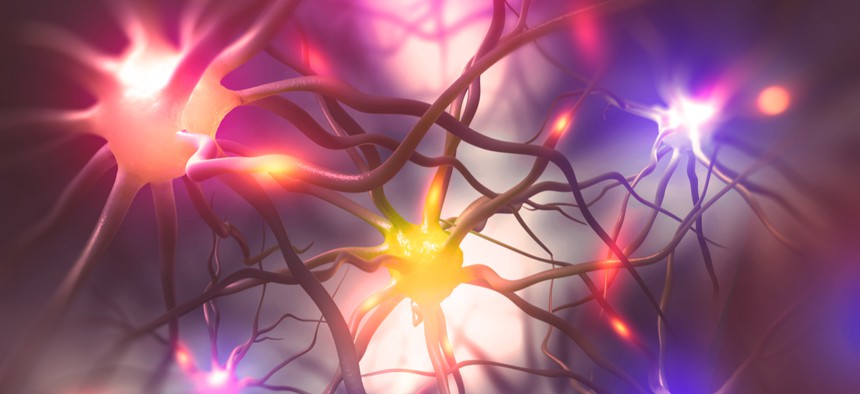Lawrence Livermore Scientists Model Neural Activity from Living Human Cells on Brain-On-A-Chip Devices

Yurchanka Siarhei/Shutterstock.com
Building on years of multidisciplinary collaboration, the effort could help scientists find countermeasures against brain injury and disease.
A multidisciplinary team of Lawrence Livermore National Laboratory scientists produced three-dimensional “brain-on-a-chip” devices capturing the neural activity of live brain cell cultures cultivated outside of the human body—and a means to model the communities of interacting neurons and their network structures as they evolve.
The work is rife with technical complexities, but those involved believe it could pave the way to pinpointing effective new countermeasures against toxins or neurological disorders disrupting brain function, such as epilepsy.
“What we set out to do is to develop and converge engineering, biology and computation to develop a more representative model of the human brain physiology and function,” Nick Fischer, staff scientist and principal investigator of the effort, told Nextgov recently. “The work that we've done is really advancing the field towards that end goal.”
The brain-focused effort is a small slice of a wide range of work through which lab insiders are replicating human systems on chip-based devices. The goal is that as the technology involved advances those devices will become more applicable to humans than any animal-based testing. Fischer noted that an ultimate aim of this specific 3D brain-on-a-chip endeavor is to develop an experimental platform that provides human-relevant data to better understand how different types of drugs and therapeutics affect the function of the human brain—via an easily reproducible and simplistic, but pertinent model system.
He, as well as Jose Cadena, a researcher in the lab’s machine learning group who developed the nascent computational model, briefed Nextgov on how the effort unfolded, the next steps they aim to pursue and how crucial it was to engage an interdisciplinary group of lab officials with a diverse range of expertise.
Making and Modeling Brain-on-a-Chips
Neurons are considered basic working units of the brain that transfer information to other cells. When they communicate, neurons generate small electrical signals that micro-electrodes can pick up. Fischer and his team at the lab ignited the work in 2016 and have had multiple iterations of hardware along the way. They designed, fabricated and refined brain-on-a-chip devices with “multi-electrode arrays” engineered into them. Fischer explained the arrays are orientations of different electrodes within a sort of culture well, and the brain cells are grown on them.
“And then as these neural networks mature, these electrodes can pick up the neuronal firing,” Fischer noted, which is essentially what occurs as neurons interact and communicate electrical impulses.
The chips consist of a sort of substrate with a well in the middle with electrodes, and the electrode traces go out to connectors that Fischer said plug into an instrument that records these electrical signals being picked up from the brain cells. That instrument is connected to a computer, “so what you then end up with is kind of these small data windows for each electrode” where ups in voltage can be observed, according to Fischer. He added that the neurons were harvested from human cells purchased from a commercial vendor, and over time the scientists were able to enhance the two-dimensional chips into three-dimensional devices—which brings the work much closer their mega aim of mirroring the architectural complexities of human brains.
The 3D chips present “a very striking image where you have these sort of pillars that rise off of the surface and along these pillars are electrodes that then pick up the signals,” Fischer noted.
As the brain-on-a-chips were advancing, Cadena and other researchers built a temporal stochastic block model that can be used to visualize and track the neuronal networks as they progress on the chips. The idea was that—because officials had developed a way to study neurons in a controlled environment—they wanted a mechanism to study how those neurons and structures on the chip transformed over the course of their existence.
“There’s a lot of previous work on understanding sort of snapshots of our brain—brain data as static snapshots,” Cadena explained. “The novelty here is that this is a temporal model, meaning that we can study how the brain network changes over time.”
The original modeling experiments demonstrated that it is possible to represent what happens within human brains on a much smaller scale. And though the model was developed for data from 2D brain-on-chips, Cadena confirmed that the process can be adapted to the 3D devices.
Future Uses and the Ones that Made This Possible
The brain-activity chips and model development were underpinned by a sundry of computational scientists, engineers and biologists.
“What we had to do to advance this kind of 3D brain-on-a-chip is we needed to engineer a kind of a chip that could actually monitor neuronal function in three dimensions—and that technology was not available when we started this project, so we had to develop that in house,” Fischer explained. “So for that, we needed a lot of hardcore engineering expertise.”
A team of biological scientists were also needed to understand the cells’ functions and how they needed to be grown, nurtured and maintained on the devices. Further, insights from computational experts were also needed to develop algorithms that could make sense of what Fischer noted is the “massive amounts of data” being generated, and he noted that they were instrumental in understanding the temporal effects of these sorts of networks.
“For developing these complex systems, it's critical to have expertise in a broad range,” Fischer said.
Going forward, the researchers aim to use the model and devices to gain a greater grasp of the brain’s responses to chemical or biological agents that can negatively affect its function—and for which they're interested in developing countermeasures. The model can provide answers to specific, predictive questions about the impacts of therapeutics.
“Say we have a normal brain-on-a-chip that's functioning without any perturbation, then we have a second brain on a chip where we induce epileptic attack,” Cadena explained. “If we're evaluating some sort of drug or treatment for epilepsy, we can see if we can re-establish the brain structure in this elective state and bring it back to the normal state.”
Fischer added that there’s now an effort to study the impacts of opioids in this realm, and the team is also looking to develop additional models with regards to brain disease and injury. While the original work was funded by the Laboratory Directed Research and Development program, the team is now pursuing financial backing from external sources to both use the 3D brain-on-a-chips to screen medical treatments and to create more human-relevant models of neuronal cultures for diseases and disorders, including traumatic brain injuries.
“These projects are never, ever finished. I mean, when you identify one thing, you answer one question and 10 other questions pop up. There are a lot of areas that we would like to explore now,” Fischer said. “But I think the crux of what we wanted to develop—which was this model experimental system that's complemented by these computational models—I think we achieved that.”






